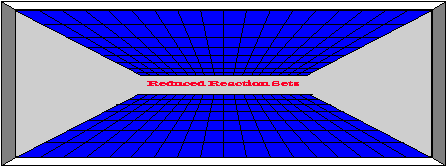 a 19-species reaction set
a 19-species reaction set
 a 22-species reaction set
a 22-species reaction set

GRI-Mech 1.2
University of California at Berkeley
Berkeley, CA 94720-1740, USA
Telephone: (510) 643-1676
Internet: myf@me.berkeley.edu
Two sets of elementary reactions reduced from GRI-Mech are
reported here. They were developed by truncation of the original GRI-Mech with the objective of developing a
smallest set of reactions (i.e.,
still a detailed mechanism but with the smallest numder of variables)
to reproduce closely the
main combustion characteristics predicted by the full mechanism, GRI-Mech.
The two sets are:
By clicking the corresponding icons above, (remember to select aload to disk option in your Mosaic
application) you can download files with the
reduced mechanisms. These are ASCII files in the CHEMKIN II format. For the
thermodynamics data you must use thermo12.dat, the thermodynamics data of
GRI-Mech. The thermo12.dat file can be
downloaded from the
GRI-Mech Home Page. If you experience difficulties
with downloading any of these files, please contact the authors.
GRI-Mech in the present case).
The following criteria are applied to identify the non-contributing reactions:
| R(i) | < e(r) | R(ref) | and
| R(i) delta-H(i) | < e(q) Q
where R(i) is the rate of reaction i, R(ref) is the rate of a reference reaction (e.g., the maximum rate), delta-H(i) is the enthalpy change of reaction i, Q is the maximum value among all the terms |R(i) delta-H(i)|, and e(R) and e(Q) are the chosen parameters considerably smaller than unity. The first criterion tests the contribution a given reaction makes to the main chain branching while the second criterion tests the contribution to the heat release.
Reactions whose rates, both forward and reverse, satisfy the above inequalities at all grid points of the calculation are removed from the mechanism. This procedure eliminates a specific species when all reactions of such a species happen to be removed.
The present reduction was performed using e(r) = e(q) = 0.02, under the following
test conditions: shock-tube ignition of methane-air mixtures at wide ranges of
initial conditions (equivalence ratio PHI = 0.2 - 2.0, initial pressure Po = 0.1
- 50 atm, and initial temperature To = 1300-2500 K); and methane-air adiabatic
flames at 1 and 20 atm. This procedure generated a 22-species, 104 reactions
set, which is referred to as DRM22.
Additional analysis of
reaction fluxes and sensitivities to removal of selected species was performed on
DRM19. Those chemical species which were showed near-zero
sensitivity were removed. This resulted in a smaller set, 19-species and 84
reactions, which is referred to as DRM19.
DRM19 and
DRM22DRM19
and DRM22, were tested against GRI-Mech using a series of ignition delay and laminar flame speed
simulations.
DRM22 works well for all the
initial conditions tested: the deviations from GRI-Mech do not
exceed 4 % and are below 2 % for most cases. DRM19 also performs
well and the deviations are typically within 6-8 % with respect to GRI-Mech. The accuracy of
DRM19 drops at lower temperatures and
higher pressures. For example, at To = 1100 K, Po = 10 atm and PHI = 0.2, the
ignition delay calculated with DRM19 has 37 % relative error. The
deviations increase further at even higher initial pressures, e.g., 89 % for
stoichiometric methane-air mixture at Po = 100 atm and To = 1050 K (for
comparison, DRM22 has 3.5 % error at these conditions). However, no
extensive tests were carried out for these conditions since GRI-Mech itself was not validated at these
conditions either.

Figure 1. Relative deviations of ignition delays calculated with the reduced
mechanisms in comparison to GRI-Mech
for methane-air mixtures: solid lines - DRM22,
dashed lines - DRM19.
DRM19 and DRM22 was also tested on
laminar adiabatic premixed methane-air flames at 1 and 20 atm, the conditions against which GRI-Mech
was optimized and validated. Four parameters were used for comparison: adiabatic
flame velocity and maximum mole fractions of major radicals, H, OH and CH3. (The
adiabatic flame temperature computed with the reduced mechanisms was found to be
practically indistinguishable from that predicted by GRI-Mech.)
DRM19 begins to deviate significantly as PHI increases
(see the top panel of Figure 2). The maximum mole fraction of OH is predicted
well by both reduced schemes for lean to stoichiometric mixtures (less than 1 %
for PHI = 1.0). As PHI increases, the accuracy of DRM19 drops (84 %
for PHI = 1.5) while that of DRM22 still remains reasonable (7.5 %
for PHI = 1.5). The maximum CH3 mole fraction is predicted within 20 % by
DRM19 (10 % for PHI = 1.0) and within 10 % by DRM22 (8
% for PHI = 1.0 ).

Figure 2. Relative deviations of adiabatic flame velocities and peak
concentrations of selected species calculated with the reduced mechanisms in
comparison to GRI-Mech for atmospheric,
adiabatic, laminar, premixed methane-air flames: solid lines -
DRM22, dashed lines - DRM19.
DRM19 is better for the lean to stoichiometric
mixtures.

Figure 3. Relative deviations of adiabatic flame velocities and peak
concentrations of selected species calculated with the reduced mechanisms in
comparison to GRI-Mech for 20-atm
adiabatic, laminar, premixed
methane-air flames: solid lines - DRM22, dashed lines -
DRM19.